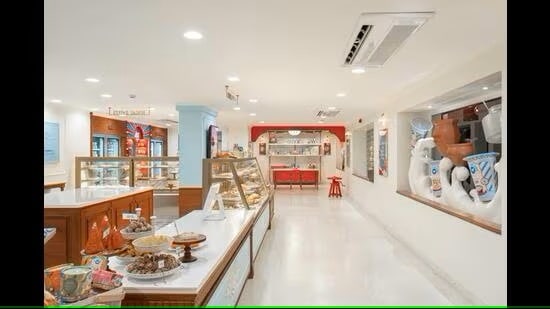
Mumbai’s Parsi Dairy Farm, the oldest operating dairy in the city, has undergone a makeover while keeping its century-old recipes intact. The 107-year-old brand has introduced new interiors and packaging, including a toffee dispenser and a yogurt cart, but has maintained the same creamy and rich malai kulfi that it has been known for. The dairy, which was founded in 1916, continues to produce dairy essentials but it’s their mithais, kulfis and toffees that are bestsellers. The new store design aims to attract customers by offering a variety of traditional Indian sweets alongside a modern touch.
MUMBAI: Four generations of the family behind Parsi Dairy Farm (PDF) have been making velvety malai kulfi. And, four generations of this correspondent’s family have been enjoying it.
The 107-year-old brand, the biggest landmark on Princess Street and the oldest operating dairy in Mumbai, has undergone a makeover in the last few months. While the interiors and the packaging are all-new (with a few added bells and whistles such as a toffee dispenser and a yoghurt cart), the creamy and rich malai kulfi is reassuringly same-old. “In the whole process of rebranding, we have systemised the way of doing things and made it to scale,” says Zeenia K Patel, brand director at PDF. “But, the recipes have not changed and will not change. Because that is what makes Parsi Dairy Farm.”
PDF was founded by Patel’s great-grandfather Nariman Ardeshir in 1916 with a single can of milk. “He started it in the same location as we are today,” she says. “He was the brain behind the recipes and many of them are century-old.” From farms in Mazgaon to stables in Andheri-Jogeshwari, PDF’s operations have now settled on a 300-acre land parcel on the Mumbai-Ahmedabad highway, which was purchased in the 1960s. While their bread and butter continues to be dairy essentials such as milk, ghee, cream and butter, it’s the mithais, kulfis and toffees that sell like hot cakes. (They have sold 50 million kulfis in the last 50 years.) “Our sutarfeni is a killer item,” says Patel. “Our kaju katlis are crazy and our barfis are famous. We make the fat jalebis, which are beloved even to Parsis, because they’re super juicy and crispy.”
Creamy and dreamy
The new store design is divided into Indian sweets, Bengali sweets, a kulfi fridge, daily essentials, a toffee dispenser, a pushcart and a gifting area. Baby blue and fire-engine red (think: colours of Yazdani Bakery) play off against the smorgasbord on display. Basins of rabri and kesar rasmalai sit next to clusters of pedas, modaks, laddoos, malai barfis and kheer kadams. Perpendicular to this Bengali section are platters of sutarfeni, Mahim halwa, Karachi jalebi, mawa khaja, ice cream barfi and double-decker barfi (because good things should come in twos).
“In the last three years, we have carried out extensive research to understand our customers, their preferences, and where our products should be positioned,” says Mehta. “That is why we’ve taken this step to make the space more lively. We’ve tried to keep the tradition with a little modernisation. We have a wall that features our old advertisements, the history, and the old packaging. Earlier, our stools were made out of milk canisters. But our research threw up that people would actually love to sit and eat comfortably. So, we don’t have to change with the times, but it’s necessary to move with the times.”
The toffee dispenser, which houses their milk drops, is another cute addition. “We want children to feel excited to come here. Otherwise, no one really wants to go and buy ghee and milk with their mum,” she says. “Our pushcart will change each month. Today, it is a yoghurt stand, tomorrow it might be a kulfi stand, or be filled with cheese dips. We have over 30 dairy products and 80 mithais. I don’t think one person has tried everything. So, we want to offer an opportunity to our customers to try something different each time they visit.”
On the day of the store’s reopening, it appears as if the entire rush of Princess Street has dropped by for a sugar rush. Commuters on their way to Marine Lines station, merchants on their way to Mangaldas Market, khaki-clad postmen with rakhis glittering on their forearms, students from the Bai Manekbai Nowrosji Girls School, clients from the Parsi Homeopathy Pharmacy across the street and employees of the local Saraswat Bank. One regular, Hema Suvarna, 52, a resident of Chira Bazaar, says, “I have been coming here since I was a student at Sir JJ Princess Street Primary School. Earlier, I used to visit for the milk, but today I have come for their mawa pan, which is my favourite. I liked the new store design very much. They have changed at the right time, with Ganpati around the corner.”

















